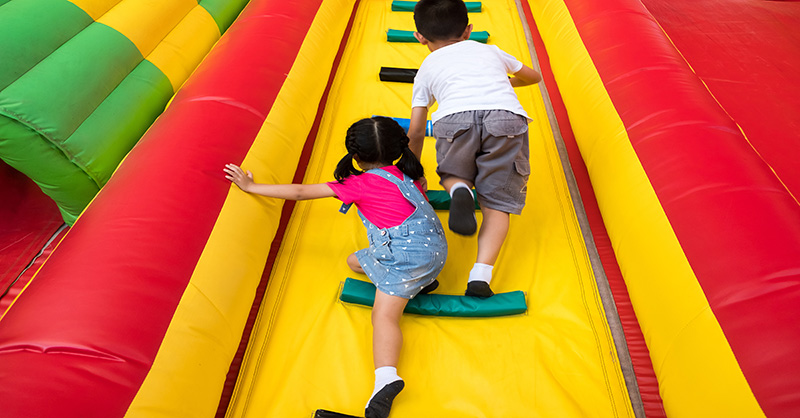Stay Safe on Inflatable Amusement Rides

Inflatable amusement rides have gained popularity over the past decade for fairs, festivals, church organizations, schools and even for home parties. The most common form of inflatable amusement ride is the “moon bounce,” also known as “bounce house” or “space walk”. Other inflatable amusements include slides, obstacle courses, and games.
While some may consider inflatable amusement rides to be harmless fun, serious injuries and even death have been associated with their use.
- Marana, AZ: Two girls were tossed out of an inflatable jumping castle when a gust of wind carried it a least 100 feet through the air. One girl was tossed out onto the ground and suffered only minor injuries; the other was ejected onto the roof of a neighbor’s house and suffered serious injuries.
- Lyons, IL: Eight children were sent to hospital after inflatable slide toppled over. Some children fell from as high as 15 feet and landed on asphalt.
- Wichita, KS: A four-year-old boy died after he fell from an inflatable attraction and landed on concrete.
These stories are only a small sample of the news headlines over recent years. The following recommendations can help your organization not only reduce its liability but also help protect your clients and customers:
- Require that the inflatable amusement ride company (vendor) be experienced and reputable.
- Require that the vendor provide your organization with certificates of liability insurance with adequate limits, naming your organization as an Additional Insured to its policy. Discuss this with your insurance agent for their professional advice.
- Do not sign a Hold Harmless Agreement with the vendor that agrees to indemnify them for liability actions that might be brought against them. Also, do not add the vendor as an additional insured to your organization’s insurance policy.
- Require that not only the vendor be responsible for set up and take down of all inflatable rides but that they also provide at least one representative to operate and supervise each ride.
- Your organization should also have a properly trained individual on site to help supervise equipment use (and the vendor). This person should be provided with the authority to close the ride if necessary.
- Consider where rides are to be set up. Not only should equipment be set up on level ground but thought should also be given to traffic patterns, other play equipment or rides, fall zones, trees, power lines or ponds/pools.
- The risk of injury increases greatly when there is a significant difference in size and ages of children using equipment at the same time. Children should be grouped by grade level and size/weight on multi-user equipment.
- Post or communicate safety regulations to staff, parents, volunteers and children. Seek parental permission (waivers) when possible.
- Always follow manufacturer’s instructions. Additional consideration should be given to maximum number of passengers at same time, no rough horseplay, no jewelry, no shoes permitted.
- Review the Consumer Product Safety Commission’s recommendations (www.cpsc.gov) prior to set up. In brief, these include:
- Minimum number of operators on a large inflatable slide is two (2) for slides over 15 feet tall; minimum number of operators on an inflatable bounce or small slide, under 15 feet, is one (1).
- Maximum recommended weight per passenger is 200 pounds, or per manufacturer’s recommendation.
- ALWAYS anchor rides per manufacturer’s requirements and instructions. Ropes, tethers, and tie-downs should be sufficiently strong to resist breakage during use.
- Do not use the inflatable ride above wind speeds that exceed the manufacturer’s recommendation. Various manufacturers recommend maximum wind speeds from 15 to 25 mph depending on the ride. However, unload and deflate any inflatable ride when the wind speed exceeds 25 mph.
Additional Reading
https://www.cpsc.gov/s3fs-public/pdfs/blk_media_amusemnt.pdf









